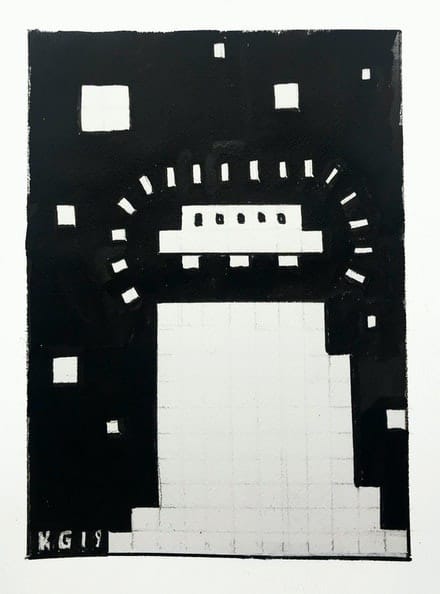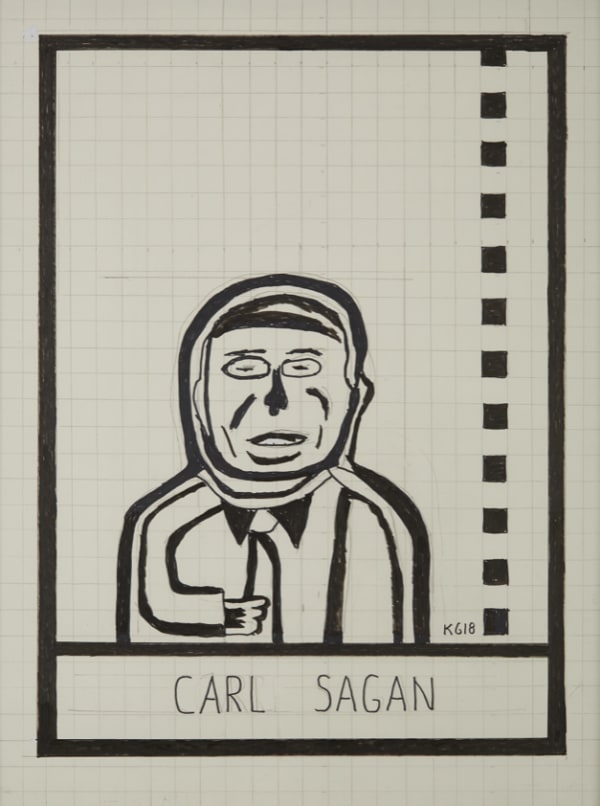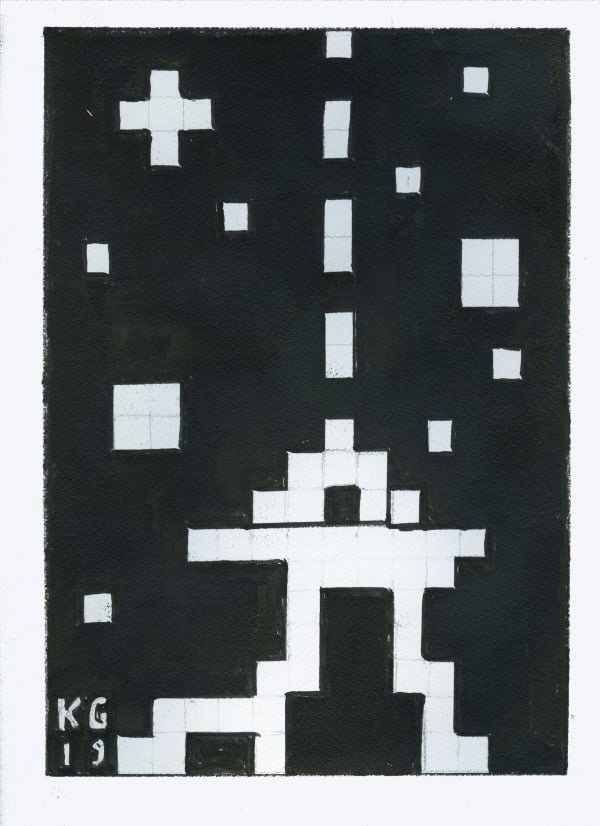Ken Grimes: Alien Variations
Back in 1998, Ken Grimes first discovered three published errors relating to the topic of Project Ozma, a pioneering SETI (Search for Extraterrestrial Intelligence) experiment launched on April 8, 1960 in hopes of detecting radio signals from extraterrestrial intelligence in our distant planetary system. The project, led by astronomer Frank Drake, used a 85-foot telescope to tune in on two solar-type stars: Tau Ceti, which yielded nothing but gaussian noise, and Epsilon Eridani, which gave off a strong and consistent signal pulsing at eight times a second for about four and a half minutes on the first day of the project. When the signal was heard again 10 days later, it was soon concluded as having been a false alarm transmitted from a high-flying passing airplane. And in July the search effort officially came to an end.
Two decades later, Grimes has now documented over 200 mistakes found in publications and documents on Project Ozma—ranging from discrepancies in the year the project began, the size of the telescope used, location and duration of the project, to information on the target star and the signal received—manifesting as blatant misinformation, typographical errors, and wrong index listings.
If a mistake is a sign of humanity, then what do we make of this strangely perpetual pattern of mistakes that bends and creates variations on the truth of what really happened? This, Grimes believes, is an alien interference with our collective unconscious that was triggered by our radio emissions leaked and activated by the initial signal heard during Project Ozma—and one that could potentially be the ultimate proof of the existence of extraterrestrial intelligence.
_______
Grimes was born in 1947 in New York and grew up in Cheshire, Connecticut. He showed keen interest in the occult from a young age, fed by his relationship with his grandfather, ‘Wizzard’ Lester Grimes, who was a remarkable magician and a friend of Houdini’s. While in college, Grimes started collecting sci-fi novels and any paperback that pertained to UFOs and other popular phenomena like Big Foot. Soon after, this affinity for worldly mysteries took a course of its own when one strange event rendered his life forever uncanny. In 1972, during a Connecticut state lottery drawing held at his family-owned indoor tennis center, Grimes tried to telepathically influence the outcome in his favor by visualizing stacks of money while walking around several hundred people gathered there, ultimately to no avail. A week later, however, he was informed that another man by the name of Ken Grimes, resident of Cheshire, England, had won the largest soccer pool in history, amounting to $1,322,988. “$1-Million Hit Separates Two Ken Grimes of Cheshire,” a headline published shortly after in Record-Journal reads, almost as a portentous introduction to the great saga that would soon begin to unfold.
Convinced this telepathic glitch—a diversion, rather—was caused by alien influence, Grimes has since developed a heightened awareness of cosmic connections and personal coincidences. He has become attuned to the architectonics of his identity, lived realities, and other outside sources like sci-fi novels—for he believes that aliens would be more inclined to leave paper trails in publications dealing with the theme of extraterrestrial encounter.
Among countless cases of what he deems to be evidence of alien influence in his life, some of the more striking examples include: the significance of the date of his birth, July 16th (the beginning of the Atomic Age via Trinity, 1945 and the launch of Apollo 11, 1969); mention of both his first and last name in more than 30 sci-fi novel passages (most notably in A. Bertram Chandler’s John Grimes: Rim Commander, p. 310: “‘Sorry, Ken,’ said Grimes.”); the coincidence of his cousin’s name being the same as that of Betty Hill, the subject of the first widely-publicized case of alien abduction; and the discovery of the Project Ozma variations, the most significant finding to date. Interpretations, theories, and predictions drawn from each and every coincidence and connection Grimes discovers are documented by means of personal notes, letters and photocopies sent to the gallery, and—after the ultimate process of refinement—works of art.
Works presented in Alien Variations embrace the idea of art-making as a way of recontextualizing factual information into an ongoing personal narrative and documenting the train of thought that pervade the mind of a truth-seeker—pushing the boundaries between public and private; evanescent and permanent—while allowing the artist himself to visualize, deconstruct, analyze, and re-envision every piece of evidence paramount to his own conviction. Certain elements are recurrent across different series, reflecting the hierarchy of significance ingrained in the artist’s perception of life and truth.
The use of text occupies a crucial dimension in Grimes’s oeuvre. Whether by recombining fragments from his notes and diaries or by incorporating a personal adage like “Sagan’s Vega is too far Epsilon Eridani is better for monitoring earth,” the artist employs the most direct and candid mode of communication within the picture plane. The portrait series, compositionally mimicking that of a professional headshot, highlights key figures like Frank Drake, Carl Sagan, and Sir Patrick Moore—whose discoveries, writings and, in some cases, “mistakes” therein have been instrumental in forming the narrative. Grimes’s index of topics (“starship,” “alien,” “radio signal”) are translated into simplified symbols that can be viewed as a pastiche of the Arecibo Message—an interstellar radio message sent to space in 1974 consisting of pulses of binary codes that form an image when translated into a grid.
Alien Variations also illuminates an evolving stylistic thread, namely the leap from the familiar territory of stark black and white palette for which Grimes is best known. His latest Untitled (Binary Code) series reimagines the fundamental means of interstellar communication by incorporating shape and color, introducing a new dimensionality in the element itself and granting the artist a new sensibility in articulating his own perception.
On the whole, the confluence of all elements deeply interconnected and indexical to the larger theme presents a quasi-theatrical revelation of the spectacular narrative in the making and the incandescent mind of its author.
When asked about his consistent compulsion to create, Grimes’s remark was simple: “what goes around comes around.” Projecting and sharing his insights in the public realm, he believes, activates the Karmic force to shed light on a new piece of evidence that will reify his beliefs. And in that, his practice is as much for the ultimate Truth as it is about his quest to get to that apex.
—KYLIE RYU
-
 Ken Grimes, Untitled Binary Code Series (Colored Code Yellow Vertical Stripe), 2019
Ken Grimes, Untitled Binary Code Series (Colored Code Yellow Vertical Stripe), 2019 -
 Ken Grimes, Untitled Binary Code Series (Yellow and Red Shapes), 2019
Ken Grimes, Untitled Binary Code Series (Yellow and Red Shapes), 2019 -
 Ken Grimes, Untitled Binary Code Series (Red and Blue Rectangle), 2019
Ken Grimes, Untitled Binary Code Series (Red and Blue Rectangle), 2019 -
 Ken Grimes, Untitled Binary Code Series (Red X), 2019
Ken Grimes, Untitled Binary Code Series (Red X), 2019
-
 Ken Grimes, Untitled Binary Code Series (Yellow Large Horizontal Stripe), 2019
Ken Grimes, Untitled Binary Code Series (Yellow Large Horizontal Stripe), 2019 -
 Ken Grimes, Untitled Binary Code Series (Blue Horizontal Stripe), 2019
Ken Grimes, Untitled Binary Code Series (Blue Horizontal Stripe), 2019 -
 Ken Grimes, Wizzard Lester Grimes, 2018
Ken Grimes, Wizzard Lester Grimes, 2018 -
 Ken Grimes, Carl Sagan, 2018
Ken Grimes, Carl Sagan, 2018
-
 Ken Grimes, Patrick Moore, 2018
Ken Grimes, Patrick Moore, 2018 -
 Ken Grimes, ET Starship at Epsilon Eridani, 2019
Ken Grimes, ET Starship at Epsilon Eridani, 2019 -
 Ken Grimes, Epsilon Eridani, 2019
Ken Grimes, Epsilon Eridani, 2019 -
 Ken Grimes, Receiving Signal, 2019
Ken Grimes, Receiving Signal, 2019


















